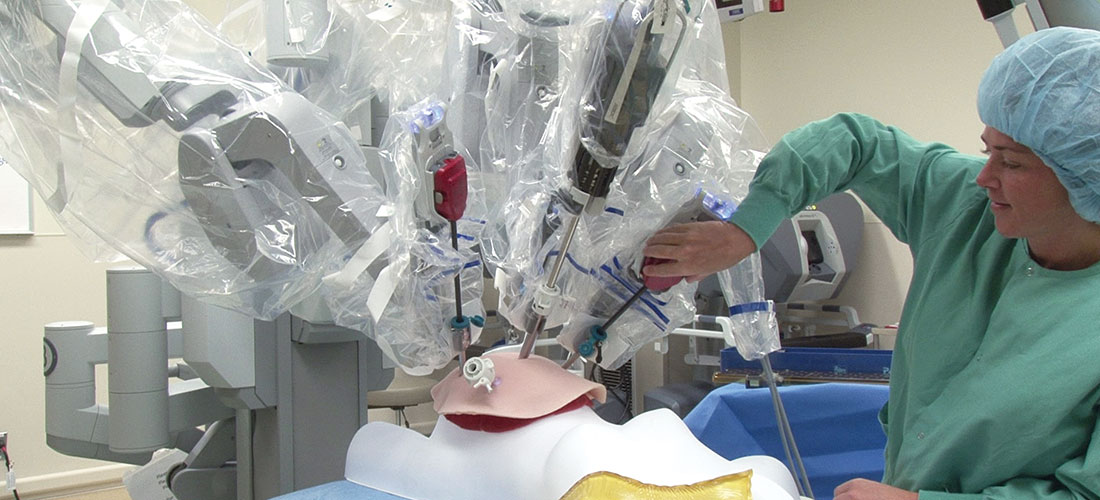5 Ways Robotic Technology Is Transforming Knee Replacement
By: Aorn Staff
Published: 4/6/2022
5 Ways Robotic Technology Is Transforming Knee Replacement
A Conversation with Kevin Barga, MS, RN

With features such as CT-based 3D modeling of bone anatomy for pre-surgical planning, and haptic boundaries to help prevent soft tissue damage, robotic-arm assisted technology has shown improved outcomes for one of the most rapidly growing ortho procedures. Here’s what nurses need to know.
Robotic-assisted technology is becoming more popular in orthopedics, especially for total knee arthroplasty (TKA)—a procedure projected to increase 600% over the next decade.1
With more robotic-assisted TKA surgeries, we now have more literature demonstrating that this technology has positively impacted surgical team efficiency and patient outcomes.
Perioperative nurses play a critical role in understanding this literature and becoming familiar with the ways robotic-assisted technology can help achieve patient outcomes in TKA procedures.
Here are five ways research is showing us how robotic technology has enhanced TKA procedures.
1. Greater accuracy compared to plan2
Through three-dimensional pre-planning, the surgeon can map out the correct site for the implant, plan how the cuts will be made, and make any intraoperative adjustments to ensure accurate implant placement to plan. Research showed that implant placement was more accurate to plan in robotic-assisted TKA compared to manual TKA.
2. Haptic boundaries3
Virtual boundaries for the bone saw, which are defined by the pre-operative plan and any intraoperative adjustments, have been shown to protect the medial and lateral compartment iatrogenic soft tissue from inadvertent cuts that can increase a patient’s postoperative pain and extend recovery.
3. More efficient surgical duration vs. conventional TKA4
Pre-planning to support implant size prediction for TKA has been shown to accurately predict implant size and correct implant placement. This may potentially lead to fewer trays needed and potentially reduces the chance for surgical delays.
4. Improved patient outcomes compared to conventional TKA5
Research showed that robotic-assisted TKA is associated with improved early functional recovery, statistically significant reduction in postoperative pain and pain med requirement and shortened length of hospital stay compared to conventional TKA.
5. Decreased costs compared to conventional TKA6
With every additional unexpected outcome during and after TKA surgery, costs increase, especially when unplanned intraoperative events lead to increased length of stay or patient readmission. Research showed that 90-day episode of care costs decreased with robotic-assisted TKA.
In our ever-driven focus on value in healthcare, applying optimized robotic-assisted TKA technology that has the potential to add value in many areas presents a solution for surgical teams and their patients.
Barga and his co-authors will be sharing more data on robotic-assisted TKA at AORN Global Surgical Conference & Expo. Make time to meet with poster authors presenting their findings and work April 7-9 at the Music City Center in Nashville, TN.
Interested to learn more about improving TKA outcomes? Don’t miss the presentation, Introduction to Periop 202 TM Total Knee Arthroplasty covering best practices for the surgical care of patients undergoing knee reconstruction on April 8 at 2pm in the AORN Central Theater.
1 Kurtz S, Ong K, Lau E, Mowat F, Halpern M. Projections of primary and revision hip and knee arthroplasty in the United States from 2005 to 2030. J Bone Joint Surg AM. 2007;89(4):780-785.
2 Hampp, E, et.al., Robotic-Arm Assisted Total Knee Arthroplasty Demonstrated Greater Accuracy and Precision to Plan Compared with Manual Techniques, J Knee Surg. 2018 May 1
3 Khlopas, A, et.al., Robotic-Arm Assisted Total Knee Arthroplasty Demonstrated Soft Tissue Protection. Surg Technol Int. 2017 Jul 25; 30:441-446
4 Bhimani, S., Bhimani, R., Feher, A., Malkani, A. Accuracy of preoperative implant sizing using 3D preplanning software for robotic-assisted total knee arthroplasty. AAHKS 2017 Annual Meeting. 2-5 Nov 2017. Dallas, TX.
5 Kayani, B. et al. Robotic-arm assisted total knee arthroplasty is associated with improved early functional recovery and reduced time to hospital discharge compared with conventional jig-based total knee arthroplasty. Bone Joint J 2018;100-B:930–7
6 Cool, C, et al. A 90-day episode-of-care cost analysis of robotic-arm assisted total knee. J. Comp. Eff. Res. 10.2217/cer-2018-0136.

